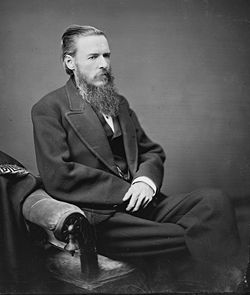| 44th United States Congress | |
|---|---|
43rd ← → 45th | |
 United States Capitol (1877) | |
March 4, 1875 – March 4, 1877 | |
| Members | 76 senators 293 representatives 9 non-voting delegates |
| Senate majority | Republican |
| Senate President | Henry Wilson (R) (until November 22, 1875) Vacant (from November 22, 1875) |
| House majority | Democratic |
| House Speaker | Michael C. Kerr (D) until August 19, 1876 Samuel J. Randall (D) from December 4, 1876 |
| Sessions | |
| Special [a] : March 5, 1875 – March 24, 1875 1st: December 6, 1875 – August 15, 1876 2nd: December 4, 1876 – March 3, 1877 | |
The 44th United States Congress was a meeting of the legislative branch of the United States federal government, consisting of the United States Senate and the United States House of Representatives. It met in Washington, D.C. from March 4, 1875, to March 4, 1877, during the seventh and eighth years of Ulysses S. Grant's presidency. The apportionment of seats in the House of Representatives was based on the 1870 United States census. For the first time since the American Civil War, the House had a Democratic majority. The Senate maintained a Republican majority.
Contents
- Major events
- Major legislation
- State admitted
- Party summary
- Senate
- House of Representatives
- Leadership
- Senate 2
- House of Representatives 2
- Members
- Senate 3
- House of Representatives 3
- Changes in membership
- Senate 4
- House of Representatives 4
- Committees
- Senate 5
- House of Representatives 5
- Joint committees
- Caucuses
- Employees
- Legislative branch agency directors
- Senate 6
- House of Representatives 6
- See also
- Notes
- References
- External links










